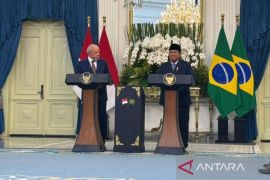In order to watch the game, the committee has prepared a special room, equipped with six vugraph screens that shows the cards on the television and followed the match itself.
One of the screens was a giant vugraph placed in a separate spot, and paired with approximately 50 chairs.
There were only a handful of audience who came for the match, most of which were, in fact, athletes officials and committee members.
This is the first time bridge is being included in the Asian Games and it surely gave a drastically different sight compared to other sports.
Even the spectators could not watch the match directly, unlike other sports, as the bridge competition took place on the first floor of the venue, while the audience were placed on the third floor.
In order to follow the game, people would have to look at the vugraph screens, which show images on the cards that were being played on the match.
People who are not familiar with bridge will surely get confused as it is unlikely for them to understand the meaning behind icons and numbers on bridge cards.
For bridge fans who came to witness the match, the committee installed a big screen and several large-sized televisions, and about 50 seats for the audience.
A handful of spectators seemed to really enjoy the match presented through the screen and they were heard discussing the course of the match.
If it is likened to an art work, bridge sports are like an abstract painting by Indonesian painter Affandi or a Spanish Pablo Picasso maestro that not many people can enjoy. Only certain groups who have come to the exhibition, can enjoy the paintings that appear only in the form of scribbles or sketches.
Bridge is a sport that is far from the roar of the audience or celebrations like those shown by badminton athletes, basketball or football. There will be no spectators who paint their faces with flag colors, or don thematic and unique costumes.
It is a quiet sport and far from the frenzy, so those who are in the arena do not feel the typical aura of a competition as presented in the arena of other matches.
Silence does not only occur in the spectators area, but also in the workspace of journalists which is the press center venue. Only one single Japanese journalist was seen working in front of a portable computer.
Egi Pahlevi and Maghvira Ramadhanty, two volunteers on duty, did not have to run around and provide journalists with the information they might inquire.
Even if there were reporters coming in, Ramadhanty said, it was just to ask for a match schedule, and they will leave immediately.
"If I can choose I actually want to be assigned to the badminton or basketball branch because understand it and actually am fond of the sport," said Ramadhanty, who is a first year student from Pamulang University, Ciputat, South Tangerang.
Lenny Novera, one of the spectators at the bridge arena, admitted that she deliberately came because she was curious about the brain teaser sport. It did not occur in her mind that the spectators would not be able to directly meet or watch the athletes competing.
The 45-year-old woman who lives in Rawamangun, Jakarta, later admitted that one of the reasons she came to the bridge arena was because she wanted to meet and take pictures with Michael Bambang Hartono, a 78-year-old bridge athlete who was the most senior athlete in the Indonesian contingent.
Bambang Hartono is none other than the boss of the giant Djarum Group and also the richest man in the country.
"I thought I could meet and take pictures with the richest person in Indonesia," she said with a disappointed face.
According to the 2017 edition of Forbes magazine, Bambang and his brother Robert Budi Hartono`s wealth is at 32.2 billion US dollars and they are also ranked 75th as the richest people in the world.
Debut in the Asian Games
After years of struggle, bridge was finally accepted by the Olympic Council of Asia (OCA) to be contested in the 2018 Asian Games stage.
Bambang Hartono, as President of the Southeast Asian Federation of Bridges, played a role in convincing high official of the OCA Sheikh Ahmed Al-Fahad Al-Ahmed Al-Sabah, who previously insisted on refusing because the bridge was considered close to gambling.
"The OCA initially objected because bridge was linked to gambling games, but they finally accepted after it was explained that the sport was popular in Islamic countries and that it actually had world champions," Bambang Hartono said a few days before the opening ceremony of the 2018 Asian Games.
The bridge game, he said, was almost the same as the business process he lived in, there was a process of collecting data, making decisions and implementing strategies.
As a newcomer sport, bridge at the 2018 Asian Games contributed a new colour in the four-yearly sports convention, aside from being enlivened by one of the richest businessmen in the world, it also provided a gathering space for senior athletes.
According to the data from the competition committee, the most senior athlete is not Bambang Hartono, but bridge athlete from the Philippines, Kong Te Yang, who is 85 years old.
Bridge sports, according to Kong, cannot be compared to other types of sports that bears the motto, "fastest, highest and strongest". Bridge sports can actually exceed the limits of an athlete`s physical strength.
"Bridge is a very mathematical sport, you also have to understand various possibilities, knowing the psychology of the opponent at all times, and you must have an open mind," he said.
At the 2018 Asian Games, bridge, which will end on September 1, contested six numbers, three in team categories and three in pair categories.
Editing by Andi Abdussalam
Reporter: Atman Ahdiat and Aria Cindyara
Editor: Heru Purwanto
Copyright © ANTARA 2018












